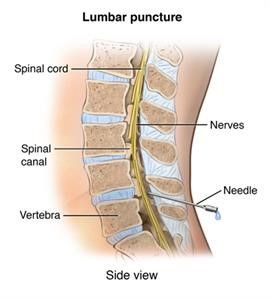Brain and Spine Care
Want to learn more about this at Kettering Health?
What is a subarachnoid hemorrhage?
A subarachnoid hemorrhage is bleeding in the space between your brain and the membrane that covers it. Most often, it occurs when a weak area in a blood vessel (aneurysm) on the surface of the brain bursts and leaks. The blood then builds up around the brain and inside the skull. This increases pressure on the brain. It can cause brain cell damage, life-long problems, and disabilities.
When an aneurysm is located in the brain, it’s called a cerebral, intracerebral, or intracranial aneurysm. A cerebral aneurysm often develops over a long period of time and may not cause any symptoms before it bursts or ruptures. Most aneurysms develop after age 40.
What causes a subarachnoid hemorrhage?
A subarachnoid hemorrhage may cause a type of stroke called a hemorrhagic stroke. This type of stroke causes bleeding inside the brain. It is different from an ischemic stroke, which is caused by a blood clot.
This bleeding may go through the brain tissue and leak into the area outside the brain. This area is called the subarachnoid space. This can be life threatening. The blood from the hemorrhage can compress or displace vital brain tissue. A severe hemorrhage can cause a coma. Or it can leave you paralyzed.
What are the symptoms of a subarachnoid hemorrhage?
Common symptoms include:
- Loss of consciousness
- Double vision
- Nausea or vomiting
- Severe headache, the worst headache pain you’ve ever had that feels different from other headaches
- Trouble speaking
- Drooping eyelid
- Confusion and trouble concentrating
- Sensitivity to light
- Neck stiffness
- Seizures
These symptoms may look like other health problems. Get medical care right away if you have these symptoms.
A brain aneurysm can lead to a subarachnoid hemorrhage. A brain aneurysm can cause these symptoms:
- Pain around the eye
- Changes in your vision
- Dilated pupils
- Weakness or numbness on 1 side of your body
- Loss of hearing or trouble with balance
- Seizures
- Trouble with memory
How is a subarachnoid hemorrhage diagnosed?
If you have symptoms of a subarachnoid hemorrhage, a healthcare provider might use several tests to diagnose it:
- MRI scan. This test uses large magnets, radio waves, and a computer to make detailed images of the brain. It doesn’t use X-rays.
- CT scan. This test uses X-rays and a computer to make horizontal (axial) images of the brain. CT scans are more detailed than general X-rays.
- Angiogram.During this test, contrast dye is injected in the blood vessel and then X-rays are taken to assess blood flow through them.
- Spinal tap. In this test, a special needle is placed into the lower back, into the spinal canal. The pressure in the spinal canal and brain can be measured. A small amount of cerebrospinal fluid (CSF) can be removed. The CSF is checked for blood.
A diagnosis of a cerebral aneurysm isn’t usually made until a subarachnoid hemorrhage has already occurred.

How is a subarachnoid hemorrhage treated?
A subarachnoid hemorrhage is a medical emergency. Immediate treatment is needed to help reduce the risk for permanent brain damage. The main goal is to stop the bleeding. Often, a healthcare provider may do surgery to place a small clip on the blood vessel to stop blood from leaking into the brain.
Some types of aneurysms can be treated with an endovascular coil. This procedure is done by either a radiologist or a neurosurgeon. It is done with a tiny incision in your groin. A thin tube called a catheter is put through the incision into the artery in your leg. It is pushed up to the artery in your head that is bleeding. Recovery time from this type of treatment is much shorter than traditional surgery. But not all aneurysms can be treated this way. Your healthcare provider can determine if you are a candidate for this treatment after doing an angiogram.
Part of the long-term treatment of a subarachnoid hemorrhage involves addressing any risk factors that may have helped trigger the hemorrhage. One of the biggest risk factors is smoking. If you smoke, you need to quit. Gaining better control of conditions such as diabetes, high cholesterol, or high blood pressure are also important. Keeping a healthy body weight and eating a healthy diet can also reduce your risk.
What are possible complications of a subarachnoid hemorrhage?
After a subarachnoid hemorrhage, serious complications can occur. Swelling in the brain (hydrocephalus) is 1 of the possible problems. It’s caused by the buildup of CSF and blood between the brain and skull, which can increase the pressure on the brain. A subarachnoid hemorrhage can also irritate and damage the brain’s other blood vessels, causing them to tighten. This reduces blood flow to the brain. As blood flow becomes affected, another stroke can happen. This can lead to even more brain damage. In serious cases, the bleeding may cause permanent brain damage, paralysis, or coma.
When should I call my healthcare provider?
The sooner the bleeding in the brain is controlled, the better the outlook. Get emergency medical help if you have any signs such as:
- Seizures
- Severe headache; the worst headache pain that you have ever had
- Nausea and vomiting with the headache
- Double vision
- Neck stiffness
- Trouble speaking
- Drooping eyelid
- Confusion and trouble concentrating
- Sensitivity to light with the headache
Key points about a subarachnoid hemorrhage
- A subarachnoid hemorrhage means that there is bleeding in the space that surrounds the brain.
- It is life threatening and a medical emergency.
- It usually occurs in people over 40 years of age.
- It usually presents as the worst headache of your life and is often followed by loss of consciousness.
- Seek immediate medical treatment if any of the above symptoms affect you or a loved one.





